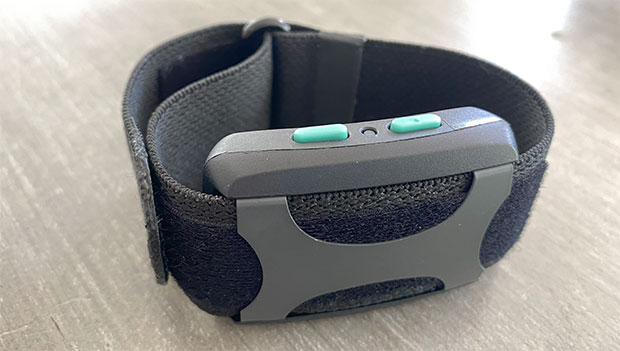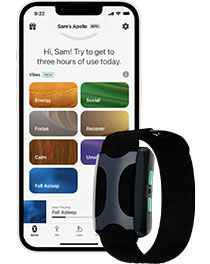As someone who struggles with anxiety and lives a high-stress life, I’m always looking for things that can help calm me down. I’ve tried various supplements and CBD oil (among other things) and they help to some extent, but my resting heart rate is still well above average. After some consultations with doctors (and research of my own), I’ve discovered the reason for this is that my body is often in fight-or-flight mode. In short, my nervous system is always sending a message to my body that there’s danger on the horizon, even if there isn’t.
Unfortunately, this is really common in today’s world, and that’s why the Apollo Neuro was born. Without getting too into the science (there’s a ton on the brand’s website if you want to dive in), the Apollo Neuro Wearable™ uses vibration touch therapy to stimulate the vagus nerve, which is a key part of your parasympathetic nervous system—a network of nerves that tells your body to calm down. There’s lots of science to support the idea of vagal nerve stimulation, but does this device do it effectively?
In this Apollo Neuro review, I’ll highlight the features of the device and share my personal experience wearing it for 30 days.
A Quick Look at the Apollo Neuro
SPECS
- Display: None
- Compatibility: Apple Health and Oura Ring
- Features: Seven vibration modes, usage tracking, benefits score, automatic scheduling
- Design: Elastic velcro strap and clip with two buttons on the side of a plastic face
The Apollo Wearable™ isn’t just another wearable device that does the same thing as all the others. While most wearables are focused on tracking biometrics like heart rate, sleep, respiration, activity level, calorie burn, etc., the Apollo Wearable™ is really more of a therapy device that actively improves your health. It relies on haptic feedback, or a small vibration, to communicate with your nervous system to help calm you down (I’ll get into this more later).
Because of this, it’s not very feature-rich. In fact, it really does one thing: sends small vibrations out in predetermined patterns. There are seven “Vibes,” each of which is designed to help you in a specific way. Apollo Vibes include Energy, Focus, Social, Recover, Calm, Unwind, and Fall Asleep. The idea is that the different vibration patterns affect your body in different ways to help reduce overall stress and help you manage your day better. You can access each Vibe through the device’s app (available on iOS and Android). All you have to do is choose the one you want to do, and the band will start vibrating accordingly.
What We Like
- Easy to use
- Effective and based on scientific research
- Can set up automatic schedules for the device to turn on
- Can wear on wrist or ankle
- Comes in 6 colors
What We Don’t Like
- Bulky
- No screen/must be controlled through app
- Doesn’t track any stats without connection to another app
A Closer Look at the Apollo Wearable™
Design and display
As far as design goes, the device is quite simple. The Apollo Wearable™ has an elastic, neoprene band with polyester overlays. The strap is velcro so you can easily remove it and put it back on, or switch it from your wrist to your ankle. It comes in three sizes—small, medium, and large—but this just relates to the band size, not the size of the device itself. In addition to the band, the device comes with a clip that can be attached to your waistband, shirt collar, or bra for a more discreet experience.
There’s no display—instead, there’s a solid plastic face with two buttons on the side that allow you to control the intensity of the vibration. Aside from that, you have to control the Apollo Wearable™ via the app. I don’t love the look of the device—it’s very similar to the Whoop but a lot bulkier. It does come in six colors so you can choose the one that goes best with your style, but ultimately it’s not going to be a fashion statement.
Connectivity
The Apollo Neuro is Bluetooth BLE 5.0-enabled. When you purchase the device, you get access to the compatible app. It also integrates with Apple Health and the Oura Ring, but it doesn’t provide any stats or biomarkers itself. You can use these other trackers to see the effect of the Apollo Neuro. For example, you might notice that your resting heart rate trends down over time or your sleep metrics improve, but Apollo’s app doesn’t provide any detailed information beyond usage and perceived benefits.
Battery Life
Apollo Neuro estimates the battery life of the Apollo wearable to be around six to eight hours of continuous use. The company recommends using the device for about three hours per day for best results, which is what I typically stuck with. I controlled the device manually and didn’t use any scheduling program. At the end of the day, my Apollo Neuro typically ended at about 70% battery life. I had to charge it every other day or so.
Water Resistance
The Apollo Neuro is water-resistant, but it’s not waterproof. While it can handle splashes and some light exposure to water, it shouldn’t be worn in the shower, bath, or while swimming. While it is water-resistant, the neoprene band feels a little uncomfortable when wet, so I tried to keep it as dry as possible.
Price
There’s only one upfront cost for the Apollo Neuro. It retails for $349, and you get ongoing access to the app without having to pay a subscription fee. They recently launched a new subscription service called Apollo Labs, which is an annual membership that unlocks the first responsive wearable technology that gives you more sleep—but it’s a totally optional add-on.
How Does the Apollo Wearable™ Look and Feel?
The Apollo Wearable™ looks like a fitness watch but without an actual display. It’s bulkier than other wearable devices I’ve tried, including a FitBit, Apple Watch, and Whoop, so I found myself taking it off more often than those.
"Since it doesn’t track metrics, I didn’t feel the need to keep it on all day—instead, I put it on in the morning and evening when I wanted to go through one of the Vibes."
It’s comfortable enough. It has a neoprene band that has a full velcro panel so you can easily adjust the size as needed. This also makes it easier to move from your wrist to your ankle. The band didn’t dig into my skin or cause irritation, I just didn’t love wearing the bulky device all day. I have the all-black version, but it does come in five other colors now.
Apollo Neuro Cost
The Apollo Neuro retails for $349. This includes the device, a band, and a clip. Unlike other wearable devices, there’s no ongoing subscription fee. Once you pay the upfront cost, you can connect to the free app and use it as much as you want.
Setting Up the Apollo Wearable™
Setting up the Apollo Wearable™ is really straightforward. There’s no display on the device itself, so setup only involves downloading the app and pairing the Apollo Neuro to your phone. After downloading the app, you’ll be prompted to sign up for an account. Once you go through those steps, the app walks you through a connection process.
You’ll see the word “connecting” appear on the screen and the app will begin searching for your device. You’ll be prompted to press one of the raised buttons on the device to connect via Bluetooth. Once the app is connected, you’ll get a quick set of instructions on how to use the device. The whole process took less than two minutes.
How Does the Apollo Wearable™ Work?
This is the million-dollar question. The Apollo Neuro works by aiming to improve cardiovascular metrics like heart rate variability (HRV), which is one of the most reliable ways to determine your resilience to stress. In other words, a low HRV indicates that you’re not managing or adapting to stress well. On the flip side, a high HRV means you’re more resilient and able to rebound from stress faster. The idea is that we can’t ever fully get rid of stress, but we can come up with ways for our bodies to better manage it and recover from it.
The Apollo Wearable™ uses small vibrations to train your nervous system in a similar way to other modalities, like yoga, meditation, and deep breathing. That’s because these vibrations stimulate the vagus nerve, which is the main communication pathway in your parasympathetic nervous system—or the branch of the nervous system that’s responsible for rest and recovery.
When you’re in this parasympathetic state, you feel calmer, can concentrate better, and get better sleep. Conversely, if your sympathetic nervous system is dominating, you may feel rushed, overwhelmed, and anxious all the time.
And this is based on science, not just a fly-by-night theory. There are two double-blind randomized placebo-controlled crossover clinical trials (known as the golden standard in research) showing statistically significant improvement in HRV and cognitive performance. There are a total of 7 complete clinical trials, and with 14 more in progress.
"Another benefit of vibration therapy is that it’s more passive than other modalities like yoga or meditation. Because of this, you can use it anytime, like during meetings or while you’re driving."
You don’t have to carve out dedicated time to do it and it’s rather effortless to integrate into your life. Of course, this doesn’t take the place of these other things; it just makes it easier to incorporate additional stress management into your day.
Is the Apollo Wearable™ Worth It?
In my opinion, the Apollo Wearable™ is worth it. I’ve been using the device consistently for over a month and I’ve noticed significant improvements in my overall stress and anxiety levels. It is important to maintain a healthy lifestyle in other areas, such as getting enough sleep and making sure to eat balanced meals, but I think it’s a worthwhile adjunct to those basic lifestyle factors.
Our Verdict
The Apollo Wearable™ is an easy way to help manage stress and improve focus and concentration in your daily life. You’ll still have to put in other work, like meditating and managing your work/life balance, but it’s been a welcome addition to my routine. I don’t love the design—it feels bulky on both my wrist and my ankle—but the trade-off has been worth it. If you need help with stress management and don’t mind using a wearable device, it’s a good option for you.
Why Trust Us?
ACTIVE.com’s editorial team relies on the knowledge and experience of fitness and wellness experts including competitive athletes, coaches, physical therapists, nutritionists, and certified trainers. This helps us ensure the products we feature are of the highest standard. Collectively, the team has spent countless hours researching equipment, gear, and recovery tools in order to create the most accurate, authentic content for our readers. Customer satisfaction is also a key part of our review process, which is why we only feature products that are highly rated.
FAQs
Does the Apollo Wearable™ help with anxiety?
In my experience, yes. But everyone is different. If you’re struggling with major anxiety, the Apollo Wearable™ likely isn’t going to be the sole solution, but it’s been a helpful part of my stress management routine.
How long does it take for the Apollo Wearable™ to work?
Apollo Neuro says that some people may notice the device’s effects right away—I felt a difference in my stress levels after the first hour of using it—but the company recommends using it consistently for at least 30 days before deciding if you think it’s working for you.
How long does Apollo Wearable™ last?
The Apollo Wearable™ battery lasts six to eight hours. The device itself has a limited warranty that covers it from defects in material and workmanship for up to 12 months.
Is the Apollo Neuro better on the wrist or ankle?
This is largely a personal preference. Apollo recommends wearing it on the inside of either your wrist or ankle, but says it can also be worn on the outside of either. If you want to wear it mostly on your ankle or upper arm, the company recommends the large size. For ankle-wear, the medium is big enough to accommodate most people. Many people enjoy it on their wrist during the day and on the ankle to sleep.
How much does Apollo Neuro cost?
The Apollo Neuro retails for $349. This includes the device, a band, and a clip. The app comes with your purchase and doesn’t require an ongoing subscription.
What intensity should I use for Apollo Neuro?
The intensities are automatically set in each Vibe. For example, if you want to use the Apollo Neuro for sleep, it defaults to a 40% intensity. If you want to use it for more focus, it defaults to a 15% intensity. That being said, the right intensity depends on where you wear it. The vibration is more intense on larger bones, like your chest or spine, so if you wear it in these areas, you’ll want to start with a lower intensity than the wrist or ankle. Ultimately, you should set the intensity so it isn’t distracting, but rather just barely perceptible. It’s normal to forget you’re wearing it as the vibrations fade into the background.







